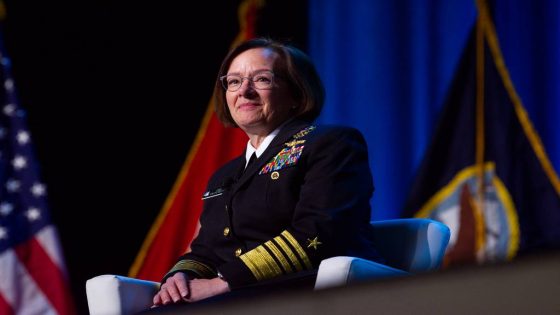As the U.S. Navy, Coast Guard and Maritime Administration press the shipbuilding industry to increase production, the services are also considering other ideas to get ships in the water faster.
During a panel discussion at the Navy Leagueâs annual Sea Air Space conference being held this week at National Harbor in Maryland, Chief of Naval Operations Adm. Lisa Franchetti described the Navy having 88 ships on contract, 66 in construction, and 57 planned for acquisition across the five-year budget planning period. Commandant of the Coast Guard Adm. Linda Fagan spoke of being in the midst of âthe largest acquisition that weâve had since World War II.â
âWe know we need a larger Navy; every study since 2016 has shown that, and I think the most effective way to work on that right now is to invest in our industrial base. Franchetti said. âInvest in the workforce. Invest in, alongside our industry partners, in the infrastructure necessary to really set the conditions to speed up the production and the throughput of the ships and submarines.â
Franchetti told Defense News these investments would take time to pay off â but the Navy needed to start budgeting the dollars now, and Congress needed to pass the spending plans on time.
âThese investments need to be made, and then theyâre going to take time to percolate through the system,â she said. âGetting a budget on time, not having a [continuing resolution], would be very helpful for us to maintain the momentum that weâre trying to achieve. But again, I think itâs going to take a couple of years before we see these investments really paying off in the ability of the of all of our shipbuilders to really produce at the scale that we need them to.â
The Navy in its fiscal 2025 budget requested $3.9 billion to support the submarine industrial base and $227 million for the weapons industrial base, among its efforts aimed at increasing throughput at factories and shipyards.
The CNO said she recently visited several shipyards, and common challenges are recruiting and retaining enough workers, having enough small businesses in the supplier base, and grappling with much longer lead times for material than had existed before.
The Navy can devote government dollars to helping address these issues, she said. But in tandem, she said it was important to focus on âprocess improvement, data analytics, having a better understanding of seeing where the choke points are,â and making sure the spending is actually leading to faster ship and submarine production.
This need to increase output comes as the Coast Guard is recapitalizing a number of ship classes, with the Polar Security Cutter being the top focus to replace its lone heavy icebreaker, the Polar Star.
âWe compete for the same industrial base space, both new construction and repair, with the Navy. And it just is critical for the nation that weâve got that kind of reliable access and commitment to the new ship capacity, and then repair capacity and maintenance capacity for the shipsâ in the Coast Guardâs fleet, Fagan said.
Until thereâs more construction and repair capacity to meet Coast Guard needs on a relevant timeframe, Fagan said Congress provided the Coast Guard some funds in FY24 to pursue another option: buying a commercially available icebreaker, which would hit the fleet much faster than the Polar Security Cutter program that Fagan hopes will start cutting steel this year.
Buying a commercial icebreaker would be âan acknowledgment of the need to have a ship with additional capacity that we are able to operate in the high latitudesâ today, she said â and while there hasnât been a larger conversation about the Coast Guard continuing to buy off-the-shelf solutions from industry, Fagan said she believed âit is probably a righteous topic to focus on.â
For the Maritime Administrationâs part, as it tries to build more dual-use ships that could carry ground forces to a fight overseas, Administrator Ann Phillips touted the benefits of a new vessel construction manager concept thatâs kept its National Security Multi-Mission Vessels on budget.
âWhatâs innovative about this is we started with a firm fixed-price contract, 100% designed and ⦠a very small change order budget, which we have not spent all of,â she said, noting the strict set of requirements the program was sticking to.
Whereas many of the Navyâs shipbuilding programs are running behind schedule and over budget, Phillips said her five NSMVs are âon budget. Weâre nearly on time ⦠And we think this particular strategy has great promise for other things.â
The vessel construction manager concept will likely be applied to a future sealift ship, for which Phillips said MARAD was given $12 million in FY24 to begin designing alongside the Navy.
Megan Eckstein is the naval warfare reporter at Defense News. She has covered military news since 2009, with a focus on U.S. Navy and Marine Corps operations, acquisition programs and budgets. She has reported from four geographic fleets and is happiest when sheâs filing stories from a ship. Megan is a University of Maryland alumna.
Source Agencies


